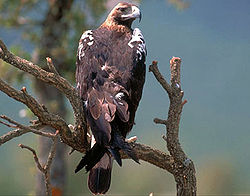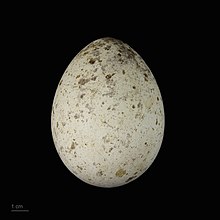Spanish imperial eagle
| Spanish imperial eagle | ||||||||||||
|---|---|---|---|---|---|---|---|---|---|---|---|---|

Spanish imperial eagle ( Aquila adalberti ), uncolored ( immature ) |
||||||||||||
| Systematics | ||||||||||||
|
||||||||||||
| Scientific name | ||||||||||||
| Aquila adalberti | ||||||||||||
| CL Brehm , 1861 |
The Spanish Imperial Eagle ( Aquila adalberti ) is a close relative of the Imperial Eagle ( Aquila heliaca ). It was named after Adalbert Wilhelm von Bayern . The species is endemic to the Iberian Peninsula .
description
The Spanish Imperial Eagle was originally considered a subspecies of the Imperial Eagle, but is now treated as a separate species that differs morphologically , ecologically and genetically from the Imperial Eagle. It reaches a length of 80 cm, a wingspan of 1.9 to 2.2 m and a weight of 2.8 to 3.5 kg. This makes it smaller than its eastern relative. The plumage is mostly dark brown in color. The neck and back of the neck are clearly contrasting light beige. The shoulders and the bow of the wing are strikingly spotted with white.
Occurrence
The Spanish Imperial Eagle is found only in southern and western Spain, as well as Portugal and possibly northern Morocco . However, only breeding sites in Spain are known.
Way of life
This eagle feeds primarily on rabbits , but it can also hunt other animals such as rodents , hares , pigeons , crows , ducks, and foxes . In contrast to the imperial eagle, which wanders long distances, the Spanish imperial eagle is a resident bird and defends an area of around 2000 hectares all year round . He is monogamous. The breeding season extends from March to July. He builds his huge clumps in single trees, such as B. cork oaks or pines . The clutch consists of one to four eggs. The young hatch after an incubation period of 43 days, but the youngest of them often do not survive. Both parents feed the young, which leave the nest after 65 to 78 days. After 5 years, the Spanish Imperial Eagle reaches sexual maturity.
Danger
This species is classified as "endangered" ( vulnerable ) by the IUCN . The current population is just over 500 specimens. Compared to 1970, when only around 100 specimens existed, this is an improvement in its situation, but it is still endangered by habitat destruction and poisonous bait. There has also been a sharp decline in the Spanish rabbit population, due to myxomatosis and other viral diseases .
Spain had a total of 253 pairs in 2008 and Portugal two pairs. A small population lives protected in the Spanish national park Coto de Doñana , but the majority is found in the Mediterranean oak forests in the central and southwestern parts of the country.
In February 2009, the male of the only Portuguese pair of imperial eagles, who successfully reared their young in 2008 , was found shot dead in the Guadiana valley .
literature
- Christian Ludwig Brehm : Something about the eagles . In: Report on the XIII. Assembly of the German Ornithological Society in Stuttgart from 17. – 20. September 1860 . C. Hoffmann, Stuttgart 1861, pp. 55-62
- Reinhold Brehm : A trip to the Basque provinces and a short stay in the Sierra de Guadarrama ..., along with a brief description of the little eagles [by CL Brehm]. In: Report on the XIII. Assembly of the German Ornithological Society in Stuttgart from 17. – 20. September 1860 . C. Hoffmann, Stuttgart 1861, pp. 95-104
- James Ferguson-Lees, David A. Christie: Raptors of the World . Houghton Mifflin, Boston 2001, ISBN 0-618-12762-3
- Miguel Ferrer: The Spanish Imperial Eagle . Lynx Edicions, Barcelona 2001, ISBN 84-87334-34-2
- Bernd Ulrich Meyburg: Imperial Eagles. In: Josep del Hoyo , Andrew Elliott, Jordi Sargatal (eds.): Handbook of the Birds of the World. Volume 2: New World Vultures to Guineafowl. Lynx Edicions, Barcelona 1994, ISBN 84-87334-15-6 , pp. 194-195.
Web links
- Aquila adalberti in the endangered Red List species the IUCN 2008. Posted by: BirdLife International, 2008. Accessed January 31 of 2009.
- Videos, photos and sound recordings of Aquila adalberti in the Internet Bird Collection
- European Commission - Action Plan for the Spanish Imperial Eagle (PDF file; 405 kB)
- Detailed species account from Birds in Europe: population estimates, trends and conservation status (BirdLife International 2004) (PDF file; 246 kB)
- ARKive - Information and photos about the Spanish Imperial Eagle
- BirdLife International: “Flying High” conserving the Spanish Imperial Eagle ( Memento from May 15, 2009 in the Internet Archive )
- Webcam at the eyrie of a breeding pair in the Spanish National Park Cabañeros
swell
- ^ Alfred Edmund Brehm: Brehms Thierleben. General knowledge of the animal kingdom , vol. 4, 2nd section, (birds, first volume). Leipzig 1882, p. 621
- ↑ Bernd Ulrich Meyburg: Imperial Eagles . In: Josep del Hoyo, Andrew Elliott & Jordi Sargatal (Eds.): Handbook of the Birds of the World, Volume 2: New World Vultures to Guineafowl Lynx Edicions, Barcelona 1994: pp. 194–195 ISBN 84-87334-15- 6th
- ↑ JA Padilla, M. Martinez-Trancón, A. Rabasco & JL Fernández-García: The karyotype of the Iberian imperial eagle (Aquila adalberti) analyzed by classical and DNA replication banding . Cytogenetics and Cell Genetics 84; 1999: pp. 61-66. doi : 10.1159 / 000015216 (HTML abstract)
- ^ The recovery of the Imperial Eagle .
- ↑ Encontrado morto o macho do único casal de águia-imperial que nidificou no país ( page no longer available , search in web archives ) (Portuguese)

